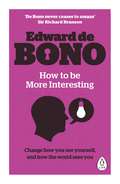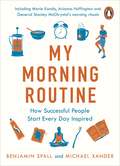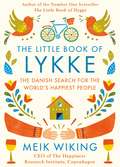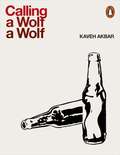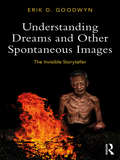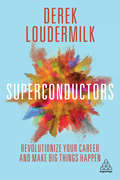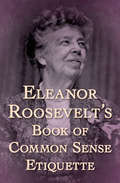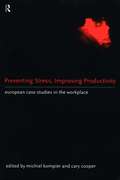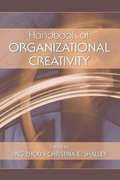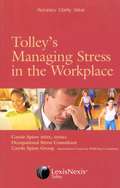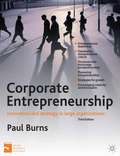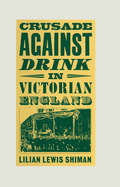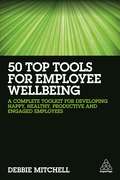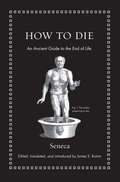- Table View
- List View
How to be More Interesting
by Edward De BonoTHE classic work about changing yourself and how others see you from the world-renowned writer and philosopher Edward de BonoPeople spend vast amounts of money, time and energy to achieve and maintain beauty, and yet despite its undisputed importance few of us devote similar efforts to be interesting. It is often thought that intelligence, beauty and confidence make you more interesting. This is not true. Being interesting is actually a state of mind. In How to be More Interesting, lateral-thinking guru Edward de Bono reveals how playing with ideas, making connections, speculating and using the imagination are at the heart of being an interesting person. With seventy exercises that will help you bring humour, insight and surprise to everyday situations, this book will ensure that people not only find you fascinating company but also won't be able to forget you.
My Morning Routine: How Successful People Start Every Day Inspired
by Benjamin Spall Michael XanderFT BUSINESS BOOK OF THE MONTH - MAY 'This small book carries the irresistible implicit promise that if you follow the morning routines of famous, important and successful people, you will become famous, important and successful yourself.' Financial TimesHow are you spending your most valuable hours? The first few choices you make each morning can unlock greater productivity, creativity, and calm - or bring out your worst self. - Marie Kondo performs a quick tidying ritual to quiet her mind before leaving the house. - The president of Pixar and Walt Disney Animation Studios, Ed Catmull, mixes three shots of espresso with three scoops of cocoa powder and two sweeteners. - Retired U.S.Army Four-Star General Stanley McChrystal works out at 4:00 AM every day for at least an hour. Part instruction manual, part someone else's diary, My Morning Routine interviews sixty-four of today's most successful people - including Biz Stone, the co-founder of Twitter; Arianna Huffington, founder of The Huffington Post; and Michael Acton Smith, the CEO of Calm - and offers advice on creating a routine of your own. Some routines are all about early-morning exercise and spartan living; others are more leisurely and self-indulgent. Whether you want to boost your productivity, implement a workout or meditation routine, or learn to roll with the punches in the morning, this book has you covered. Once you land on the right routine, you'll look forward to waking up.-----From inside the book: 'A big part of my morning routine is about what I don't do: when I wake up, I don't start the day by looking at my phone' - ARIANNA HUFFINGTON, founder of the Huffington Post and Thrive Global 'I travel a lot for work, so my days are always different. Having a morning routine really means fitting things in around everything else' - CAMERON RUSSELL, fashion model and cultural activist I'if I don't get a chance to play with my son in the morning I feel like I missed something that I'll never get back' - BIZ STONE, cofounder of Twitter 'Find certain things you know you should do, don't like to do, or make excuses to avoid, and then do them every day' - STANLEY McCHRYSTAL, retired U.S. Army four-star general------ BENJAMIN SPALL AND MICHAEL XANDER are the founders of mymorningroutine.com. Spall has written for outlets including The Huffington Post, 99U, and The Next Web. Xander is a product designer and engineer.
The Little Book of Lykke: The Danish Search for the World's Happiest People
by Meik WikingLykke (Luu-kah) (n): Happiness It's easy to see why Denmark is often called the world's happiest country. Not only do they have equal parental leave for men and women, free higher education and trains that run on time, but they burn more candles per household than anywhere else.So nobody knows more about happiness - what the Danes call lykke - than Meik Wiking, CEO of the Happiness Research Institute in Copenhagen and author of the bestselling sensation The Little Book of Hygge. But he believes that, whilst we can certainly learn a lot from the Danes about finding fulfilment, the keys to happiness are actually buried all around the globe.In this captivating book, he takes us on a treasure hunt to unlock the doors to inner fulfilment. From how we spend our precious time, to how we relate to our neighbours and cook dinner, he gathers evidence, stories and tips from the very happiest corners of the planet. This is the ultimate guide to how we can all find a little more lykke in our lives.
Calling a Wolf a Wolf
by Kaveh AkbarA POETRY BOOK SOCIETY RECOMMENDATIONI could not be held responsiblefor desirehe could not be held at allTracking the joys and pains of the path through addiction, and wrestling with desire, inheritance and faith, Calling a Wolf a Wolf is the darkly sumptuous debut from award-winning poet Kaveh Akbar. These are powerful, intimate poems of thirst: for alcohol, for other bodies, for knowledge and for life.'The struggle from late youth on, with and without God, agony, narcotics and love, is a torment rarely recorded with such sustained eloquence and passion as you will find in this collection'FANNY HOWE'Compelling . . . strange . . . always beautiful' ROXANE GAY, AUTHOR OF BAD FEMINIST AND HUNGER'Truly brilliant'JOHN GREEN, AUTHOR OF THE FAULT IN OUR STARS'A breathtaking addition to the canon of addiction literature'PUBLISHERS WEEKLY (STARRED REVIEW)
The Invisible Storyteller: Understanding Dreams And Other Spontaneous Images (PDF)
by Erik D. GoodwynUnderstanding Dreams and Other Spontaneous Images: The Invisible Storyteller applies a contemporary interdisciplinary approach to dream interpretation, bringing cognitive anthropology, folklore studies, affective neuroscience, and dynamic systems theory to bear on contemporary psychodynamic clinical practice. It provides a practical guide for working with dreams that can be used by both individuals on their own and therapists working with clients. Erik D. Goodwyn invites us to examine key features of reported dreams, such as the qualities of the environment depicted, its familiarity or unfamiliarity, the nature of the characters encountered, and overall themes. This method facilitates an understanding of the dream in the full context of the dreamer’s life, rather than interpreting individual, isolated elements. Goodwyn also introduces the mental process which orchestrates dreams, conceptualised here as the ‘Invisible Storyteller’, and explores how understanding it can positively impact satisfaction in waking life. As a whole, the book provides a collection of tools and techniques which can be referred to time and again, as well as a wealth of examples. Exploring dreams as a natural source of clinical insight, The Invisible Storyteller will appeal to Jungian psychotherapists and analytical psychologists, other professionals working with dreams with clients, and readers looking for a scientific approach to dream interpretation.
The Invisible Storyteller: Understanding Dreams And Other Spontaneous Images
by Erik D. GoodwynUnderstanding Dreams and Other Spontaneous Images: The Invisible Storyteller applies a contemporary interdisciplinary approach to dream interpretation, bringing cognitive anthropology, folklore studies, affective neuroscience, and dynamic systems theory to bear on contemporary psychodynamic clinical practice. It provides a practical guide for working with dreams that can be used by both individuals on their own and therapists working with clients. Erik D. Goodwyn invites us to examine key features of reported dreams, such as the qualities of the environment depicted, its familiarity or unfamiliarity, the nature of the characters encountered, and overall themes. This method facilitates an understanding of the dream in the full context of the dreamer’s life, rather than interpreting individual, isolated elements. Goodwyn also introduces the mental process which orchestrates dreams, conceptualised here as the ‘Invisible Storyteller’, and explores how understanding it can positively impact satisfaction in waking life. As a whole, the book provides a collection of tools and techniques which can be referred to time and again, as well as a wealth of examples. Exploring dreams as a natural source of clinical insight, The Invisible Storyteller will appeal to Jungian psychotherapists and analytical psychologists, other professionals working with dreams with clients, and readers looking for a scientific approach to dream interpretation.
Superconductors: Revolutionize Your Career and Make Big Things Happen
by Derek LoudermilkThe steady career path is a thing of the past: disruption is here to stay. You need to be able to keep learning, growing and reinventing yourself to stay valuable in the midst of this change. Those who succeed in this new world will be the ones who have skills that are always in demand and cannot be replaced. Creativity, charisma, confidence, constant learning, storytelling, adaptability and tribe building are the keys to having a thriving professional life and turning ideas into reality. Superconductors is your treasure trove of exclusive interviews and hands-on self-development exercises to inspire you and push you into action. Derek Loudermilk brings together some of the best minds to coach you on every skill, including entrepreneurs, podcasters, venture capitalist experts, human behaviour hackers, journalists and digital storytellers. Michael Margolis, Vanessa Van Edwards, Derek Muller, Jason Zook, Linda Rottenburg are just some of the people giving you original insights and advice to help you form your own path. If you're ambitious and you want to carve your place in this chaotic, but exciting, new world of work then you need to be a superconductor: you need to have the creative energy, the ability to build great networks and the charisma to make big things happen. Whether you want to live as a digital nomad, an entrepreneur or be a formidable force in your chosen industry, Superconductors gives you the unique insight and hands-on tools to be the best you can be.
Superconductors: Revolutionize Your Career and Make Big Things Happen
by Derek LoudermilkThe steady career path is a thing of the past: disruption is here to stay. You need to be able to keep learning, growing and reinventing yourself to stay valuable in the midst of this change. Those who succeed in this new world will be the ones who have skills that are always in demand and cannot be replaced. Creativity, charisma, confidence, constant learning, storytelling, adaptability and tribe building are the keys to having a thriving professional life and turning ideas into reality. Superconductors is your treasure trove of exclusive interviews and hands-on self-development exercises to inspire you and push you into action. Derek Loudermilk brings together some of the best minds to coach you on every skill, including entrepreneurs, podcasters, venture capitalist experts, human behaviour hackers, journalists and digital storytellers. Michael Margolis, Vanessa Van Edwards, Derek Muller, Jason Zook, Linda Rottenburg are just some of the people giving you original insights and advice to help you form your own path. If you're ambitious and you want to carve your place in this chaotic, but exciting, new world of work then you need to be a superconductor: you need to have the creative energy, the ability to build great networks and the charisma to make big things happen. Whether you want to live as a digital nomad, an entrepreneur or be a formidable force in your chosen industry, Superconductors gives you the unique insight and hands-on tools to be the best you can be.
Weight Expectations: One Man's Recovery from Anorexia (PDF)
by Dave ChawnerPart memoir, part self-help guide, this witty book will take you through the day-to-day struggles of living with an eating disorder. Stand-up comedian Dave Chawner tells the story of how he became anorexic, what his life with mental illness was like, and how he started his journey to recovery. Giving an anorexic perspective with a comic delivery, this book sets out practical tips, personal anecdotes and uplifting playlists to give hope to anyone in a similar situation, and provides insight into what life with mental illness is like.
Obsessive Compulsions: The OCD of Everyday Life (PDF)
by C. Thomas GualtieriAlmost everybody has an obsession or feels a compulsion to do something a certain way. Magic numbers, intrusive thoughts, unusual fears and superstitions happen to about four people out of five, but where do these obsessive-compulsive (OC) traits come from? This book explores what they are, why we have them and what we can do about them, through fascinating and highly original insights. Are you a perfectionist, or can you be fussy? Do you like to have control in certain situations? Or are you overly anxious in others? These are all OC traits, and this book looks at their recent increase in human behaviour, and how they are formed in the brain. Showing that these traits are more common in highly educated, intelligent and successful people, it highlights the positive sides of what have previously been seen as negative quirks. Weaving together sections that are anecdotal and humorous, with technical and up-to-date scientific information, this groundbreaking book gives a fascinating introduction into an under-discussed personality type.
Eleanor Roosevelt's Book of Common Sense Etiquette
by Eleanor RooseveltIn an era of incivility, discover a timeless guide to good manners from First Lady Eleanor Roosevelt. “The basis of all good human behavior is kindness,” says Eleanor Roosevelt in this classic handbook, first published in 1962 as a “modern book of etiquette for modern Americans.” As a politician, diplomat, and activist, as well as the longest-serving First Lady of the United States, Mrs. Roosevelt knew that thoughtful, civil behavior was essential to peaceful, productive relationships. In this etiquette guide, she teaches that decorum is not about strict adherence to formal rules; it is about approaching all social situations with consideration for others. She advises, “If ever you find yourself in a situation in which following a formal rule would be manifestly unkind, forget it, and be kind instead.” Drawing from her personal and professional experiences, Roosevelt covers a broad range of topics, including business dealings and family affairs, writing letters and receiving guests, and entertaining at home and traveling abroad. Beginning with the necessity of good manners between husband and wife, she considers the importance of courtesy in society at large and the role all Americans play as ambassadors of democracy while visiting foreign countries. In an era of incivility, Eleanor Roosevelt’s Book of Common Sense Etiquette is more relevant than ever. This ebook has been professionally proofread to ensure accuracy and readability on all devices.
Obsessive Compulsions: The OCD of Everyday Life
by C. Thomas GualtieriAlmost everybody has an obsession or feels a compulsion to do something a certain way. Magic numbers, intrusive thoughts, unusual fears and superstitions happen to about four people out of five, but where do these obsessive-compulsive (OC) traits come from? This book explores what they are, why we have them and what we can do about them, through fascinating and highly original insights. Are you a perfectionist, or can you be fussy? Do you like to have control in certain situations? Or are you overly anxious in others? These are all OC traits, and this book looks at their recent increase in human behaviour, and how they are formed in the brain. Showing that these traits are more common in highly educated, intelligent and successful people, it highlights the positive sides of what have previously been seen as negative quirks. Weaving together sections that are anecdotal and humorous, with technical and up-to-date scientific information, this groundbreaking book gives a fascinating introduction into an under-discussed personality type.
Weight Expectations: One Man's Recovery from Anorexia
by Dave ChawnerPart memoir, part self-help guide, this witty book will take you through the day-to-day struggles of living with an eating disorder. Stand-up comedian Dave Chawner tells the story of how he became anorexic, what his life with mental illness was like, and how he started his journey to recovery. Giving an anorexic perspective with a comic delivery, this book sets out practical tips, personal anecdotes and uplifting playlists to give hope to anyone in a similar situation, and provides insight into what life with mental illness is like.
Preventing Stress, Improving Productivity: European Case-Studies in the Workplace
by Cary Cooper Michiel KompierIn a representative study made of European workers, twenty-eight per cent of employees reported that stress affects their health and their performance at work. Occupational stress is a serious problem for the performance of individuals, organisations and as a consequence, for national economies. Preventing Stress, Improving Productivity investigates the ways in which companies can combat stress by changing the working environment rather than only treating individual employees with stress symptoms.Costs and benefits of stress prevention are discussed, with an emphasis on appraoches that involve both the work situation and the individual worker. The heart of the book consists of eleven European country chapters, each overviewing the current status with respect to occupational stress and its prevention in that country and then presenting one detailed case study an example of good preventive practice. Preventing Stress, Improving Productivity identifies five factors that are critical for a stress reduction programme to work, both in terms of employee health and well-being and from a financial point of view. Successful strategies combine participation from workers and support from top management. Useful as a reference for psychologists, human resource managers, occupational physicians, ergonomists and consultants, this book will also be an invaluable aid to managers in the day-to-day running of organisations.
Handbook of Organizational Creativity (PDF)
by Christina E. Shalley Jing ZhouThis volume is a comprehensive and cutting-edge reference book reflecting current knowledge in the rapidly growing area of organizational creativity. The contributors to this volume are all leading researchers in the field of organizational creativity. This volume: provides a historical review of organizational creativity theory and research presents critical reviews and summaries of research on micro, meso, and macro topics (e.g., leadership, feedback, goals and role expectations, groups and teams, social networks, climate and culture, deep structures, sense-making processes, and creativity and organizational change) concerning organizational creativity demonstrates contributions of creativity to individual work outcomes and organizational success discusses emerging areas and highlights promising future research trends. Professors and graduate students in management and psychology will find this volume most beneficial. Professors and graduate students in marketing, sociology, and education also may find this book useful and relevant. Thoughtful managers and executives, professionals and knowledge workers, and aspiring managers and MBA students also would find this book beneficial in sharpening their thinking, and helping them to identify the right tools for managing creativity.
Managing Stress In The Workplace (PDF)
by Carole SpiersWith one in five workers reported as having felt under extreme pressure at work, stress Is overtaking the common cold as the biggest cause of absence from work. Cases such as Walker v Northumberland County Council [1995] have put stress firmly on the workplace agenda. The HSE has established stress in the workplace as a health and safety issue that needs to be recognised and managed through the use of risk assessment. Management in all organisations is now under pressure to put preventative measures in placed and to establish effective management techniques in order to tackle work-related stress. Tolley’s Managing Stress in the Workplace is a practical handbook that guides the manager through their responsibilities in this difficult area. It provides clear guidelines on stress management and prevention techniques and contains useful checklists, best practice recommendations, and case studies throughout, as well as HSE guidance. Tolley’s Managing Stress in the Workplace addresses the key issues that organisations face today, including: * The nature of stress and its relationship to pressure * The legal and cost implications on the organisation * Identifying the current causes and effects * Bullying and violence at work * Post-traumatic stress after a critical incident * Stress and personal health issues * Individual stress management strategies * Developing and maintaining a robust organisation Being better able to effectively handle work-related stress makes for a healthier workforce, lower absenteeism, increased performance and lower staff turnover – all of which means that having the right systems in place could save your organisation substantial costs. Tolley’s Managing Stress in the Workplace is a reference manual for managers, health and safety, personnel and occupational health advisors.
Corporate Entrepreneurship (PDF)
by Paul BurnsThis leading core textbook, authored by a recognised authority on the subject, covers entrepreneurial transformation in larger organizations and shows how this can be achieved by building an organizational architecture that encourages creativity, innovation and entrepreneurship. Drawing together research from a number of business disciplines and combining this with numerous corporate examples, this innovative text explains how to create an organization that fosters entrepreneurship and how an entrepreneurial organizational structure manifests itself in different industries and companies. Written in a coherent and engaging style, this book offers an accessible combination of theory and practice that encourages students to approach the subject both critically and creatively. This is an essential textbook for students studying Corporate Entrepreneurship at upper undergraduate and postgraduate level on Entrepreneurship and Business & Management degree programmes. The book also caters for students of Entrepreneurship in Engineering and Technology Management departments, and for all those studying Strategy, Innovation and Leadership.
Shattered by Grief: Picking up the pieces to become WHOLE again
by Claudia CoenenThis is a practical guide to help readers work through their grief via expressive therapies and activities, based on the techniques Claudia Coenen honed as a professional counselor after the unexpected loss of her husband. This book provides clear methods to process grief, experience its pain and learn how to live fully again. Readers are encouraged to completely engage with their grief through storytelling, self-care and ritual, and honest reflection. The book navigates the reader through the healing process while allowing them the freedom to explore their pain in a way that best fits their unique situation. Eschewing the idea of a 'quick-fix' to grief, it suggests ways in which tragedy and loss can be a springboard for rejuvenation and transformation.
Crusade Against Drink In Victorian England (PDF)
by Lilian Lewis ShimanDrink, 'the curse of Britain', was sweeping the land, or so it seemed to many Englishmen in the early decades of the nineteenth century. They held it responsible for crime, poverty and many other ills of the rapidly industrializing towns. A 'moderation' temperance reform organized in 1829 largely under middle class auspices soon gave way to a radical commitment to total abstinence in a great variety of worker self-help groups. When these too failed to change the drinking habits of most Englishmen the temperance movement sought new alliances. In the 1870s and 1880s Gospel Temperance married temperance to revivalist religion. It received the support of both established and non-conformist churches, and millions 'took the pledge'. But many did not; and as religious enthusiasm faded the anti-drink forces shifted their attention to the political arena. After successfully pressuring the Liberal Party to adopt limited prohibition, they mounted a great but unsuccessful campaign in the 1895 election. With this defeat the anti-drink crusade disintegrated, leaving the dedicated teetotallers socially isolated in the safe haven of their drink-free subculture.
50 Top Tools for Employee Wellbeing: A Complete Toolkit for Developing Happy, Healthy, Productive and Engaged Employees
by Debbie MitchellIn a world of political and economic uncertainty where stress and unhappiness are on the rise, improving employee wellbeing has never been more important. But with budgets being squeezed and the constant need to do more with less, this can seem like an insurmountable task. 50 Top Tools for Employee Wellbeing shows that interventions don't need to be expensive or time-consuming. It contains practical tools for immediately improving staff wellbeing, resulting in happier, more engaged and more productive employees. Each tool in the book includes guidance on when to use it, how to get the most out of it and - most importantly - how to measure its impact to show what's working and where efforts are best focused. Addressing all the key areas of the subject, from career development and workplace culture to physical, mental and financial wellbeing, this is a complete resource for improving your workforce's wellbeing.
50 Top Tools for Employee Wellbeing: A Complete Toolkit for Developing Happy, Healthy, Productive and Engaged Employees
by Debbie MitchellIn a world of political and economic uncertainty where stress and unhappiness are on the rise, improving employee wellbeing has never been more important. But with budgets being squeezed and the constant need to do more with less, this can seem like an insurmountable task. 50 Top Tools for Employee Wellbeing shows that interventions don't need to be expensive or time-consuming. It contains practical tools for immediately improving staff wellbeing, resulting in happier, more engaged and more productive employees. Each tool in the book includes guidance on when to use it, how to get the most out of it and - most importantly - how to measure its impact to show what's working and where efforts are best focused. Addressing all the key areas of the subject, from career development and workplace culture to physical, mental and financial wellbeing, this is a complete resource for improving your workforce's wellbeing.
How to Die: An Ancient Guide to the End of Life
by Seneca James S. RommTimeless wisdom on death and dying from the celebrated Stoic philosopher Seneca"It takes an entire lifetime to learn how to die," wrote the Roman Stoic philosopher Seneca (c. 4 BC–65 AD). He counseled readers to "study death always," and took his own advice, returning to the subject again and again in all his writings, yet he never treated it in a complete work. How to Die gathers in one volume, for the first time, Seneca's remarkable meditations on death and dying. Edited and translated by James S. Romm, How to Die reveals a provocative thinker and dazzling writer who speaks with a startling frankness about the need to accept death or even, under certain conditions, to seek it out. Seneca believed that life is only a journey toward death and that one must rehearse for death throughout life. Here, he tells us how to practice for death, how to die well, and how to understand the role of a good death in a good life. He stresses the universality of death, its importance as life's final rite of passage, and its ability to liberate us from pain, slavery, or political oppression. Featuring beautifully rendered new translations, How to Die also includes an enlightening introduction, notes, the original Latin texts, and an epilogue presenting Tacitus's description of Seneca's grim suicide.
How to Die: An Ancient Guide to the End of Life
by Seneca James S. RommTimeless wisdom on death and dying from the celebrated Stoic philosopher Seneca"It takes an entire lifetime to learn how to die," wrote the Roman Stoic philosopher Seneca (c. 4 BC–65 AD). He counseled readers to "study death always," and took his own advice, returning to the subject again and again in all his writings, yet he never treated it in a complete work. How to Die gathers in one volume, for the first time, Seneca's remarkable meditations on death and dying. Edited and translated by James S. Romm, How to Die reveals a provocative thinker and dazzling writer who speaks with a startling frankness about the need to accept death or even, under certain conditions, to seek it out. Seneca believed that life is only a journey toward death and that one must rehearse for death throughout life. Here, he tells us how to practice for death, how to die well, and how to understand the role of a good death in a good life. He stresses the universality of death, its importance as life's final rite of passage, and its ability to liberate us from pain, slavery, or political oppression. Featuring beautifully rendered new translations, How to Die also includes an enlightening introduction, notes, the original Latin texts, and an epilogue presenting Tacitus's description of Seneca's grim suicide.
Follow the Child: Planning and Having the Best End-of-Life Care for Your Child (PDF)
by Sacha Langton-GilksDrawing on her family's own experiences and those of other parents facing the death of a child from illness or a life-limiting condition, Sacha Langton-Gilks explains the challenges, planning, and conversations that can be expected during this traumatic period. Practical advice such as how to work with the healthcare professionals, drawing up an Advance Care Plan, and how to move care into the home sit alongside tender observations of how such things worked in her own family's story. The book also includes a template person-centred planning document, developed by experts in the field. Empowering and reassuring, this book will help families plan and ensure the best possible end-of-life care for a child or young person.
Things Jon Didn’t Know About: Our Life After My Husband’s Suicide (PDF)
by Sue Henderson"Jon, my husband, took his own life at the age of 35. He left for work at 7.30, as usual. He kissed me, and our two children, as usual. He told me he loved me, which was not usual, but that didn't occur to me until later." Sue Henderson candidly recounts the experience of raising her family as a single parent survivor of suicide. Alongside an honest and moving account of the day-to-day practicalities and emotional impact of Jon's death, there's advice on how to talk to children about death and suicide, how to support them as they grow up, and how to be aware of the heightened emotional risks for bereaved children. She also draws on her experience as a social worker of 25 years to provide a theoretical framework for the book in which she discusses theories of grief and bereavement, issues of men's mental health, and the heightened incidence of male suicide.
